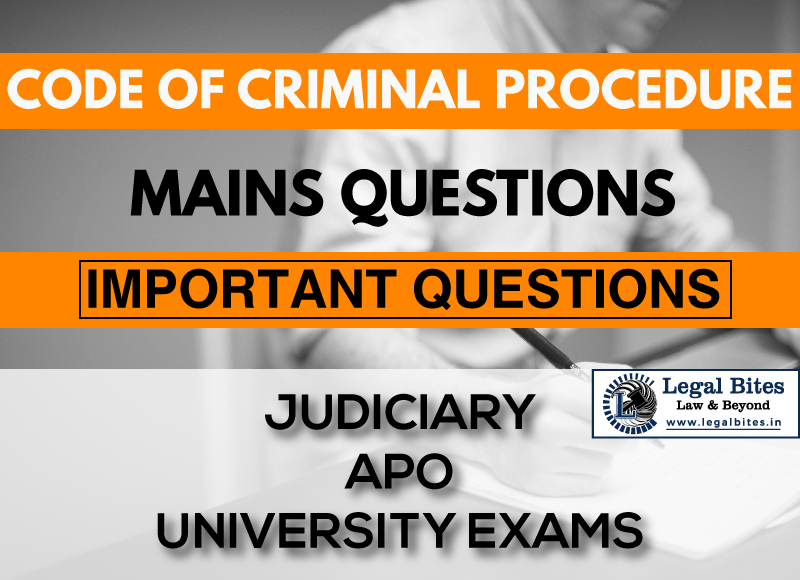What are the powers of a Magistrate and a police officer in dispersing unlawful assemblies?
Question: What are the powers of a Magistrate and a police officer in dispersing unlawful assemblies? Find the answer to the mains question only on Legal Bites. [What are the powers of a Magistrate and a police officer in dispersing unlawful assemblies?] Answer Article 19 (1)(b) of the Constitution of India 1949, provides that ‘All citizens shall have right… Read More »

Question: What are the powers of a Magistrate and a police officer in dispersing unlawful assemblies? Find the answer to the mains question only on Legal Bites. [What are the powers of a Magistrate and a police officer in dispersing unlawful assemblies?] Answer Article 19 (1)(b) of the Constitution of India 1949, provides that ‘All citizens shall have right to assemble peaceably and without arms. But this right is subject to reasonable restrictions like maintenance of public order...
Question: What are the powers of a Magistrate and a police officer in dispersing unlawful assemblies?
Find the answer to the mains question only on Legal Bites. [What are the powers of a Magistrate and a police officer in dispersing unlawful assemblies?]
Answer
Article 19 (1)(b) of the Constitution of India 1949, provides that ‘All citizens shall have right to assemble peaceably and without arms.
But this right is subject to reasonable restrictions like maintenance of public order and tranquillity. Thus, CrPC grants powers to its functionaries to disperse members of unlawful assemblies to ensure that public order and peace can be maintained in society.
According to Section 141 of the Indian Penal Code, 1860, To constitute an unlawful assembly the following 3 conditions must co-exist-
- There must be an assembly of five persons.
- The assembly must have a common object and
- The common object must be to commit one of the five illegal objects specified in the section.
The power to disperse the unlawful assembly can be exercised in three different ways under Sections 129 to 131 of the Code of Criminal Procedure.
According to section 129 of CrPC, the order to disperse any assembly that is an unlawful one and likely to cause disturbance to the public peace may be issued by-
(1) Any executive Magistrate
(2) Officer in charge of a police station or,
(3) Any police officer who is a sub-inspector or above the rank of sub-inspector in the absence of such officer in charge
When an order is passed for dispersal, it shall be the duty of the members of such assembly to disperse accordingly. After an order for dispersal is issued and such assembly disobeys the order and do not disperse, or, even if not so commanded, the assembly shows the determination of not to disperse, then any Executive Magistrate or Officers as empowered under subsection (1) of section 129 may use force in order to disperse such unlawful assembly.
If necessary, even if any male person is not an officer or member of armed force but acting as such, may arrest or confine the members of such unlawful assembly, and then they may be punished by law.
The authority to disperse an unlawful assembly has been granted to the Executive Magistrate or the officer-in-charge of a police station. In case of the absence of the officer-in-charge, a command can also be given by a police officer, not below the rank of sub-inspector.
Before any force can be used for the dispersal of an unlawful assembly, three prerequisites as mentioned in Karam Singh v. Hardayal Singh, (1979) Cri. L.J 1211 (P&H) should be satisfied.
Firstly, there should be an unlawful assembly with the object of committing violence or an assembly of five or more persons likely to disturb public peace and tranquillity. Secondly, such assembly is ordered to be dispersed immediately by the competent authority. Thirdly, in spite of such an order to disperse, such assembly does not disperse or does not, ex facie, seem to be dispersing.
Important Mains/Long Questions for Judiciary, APO & University Exams
- CRPC Mains Questions Series Part I: Important Questions
- CRPC Mains Questions Series Part II: Important Questions
- CRPC Mains Questions Series Part III: Important Questions
- CRPC Mains Questions Series Part IV: Important Questions
- CRPC Mains Questions Series Part V: Important Questions
- CRPC Mains Questions Series Part VI: Important Questions
- CRPC Mains Questions Series Part VII: Important Questions
- CRPC Mains Questions Series Part VIII: Important Questions
- CRPC Mains Questions Series Part IX: Important Questions
- CRPC Mains Questions Series Part X: Important Questions
- CRPC Mains Questions Series Part XI: Important Questions
Admin Legal Bites
Legal Bites Study Materials correspond to what is taught in law schools and what is tested in competitive exams. It pledges to offer a competitive advantage, prepare for tests, and save a lot of money.
